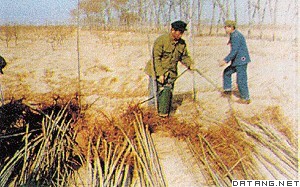2) plant disease


植物病害
1.
Segmentation technology of color image about plant disease based on BP neural network;


基于BP网络的植物病害彩色图像的分割技术
2.
Color image segmentation method based on statistical pattern recognition for plant disease diagnose;
基于统计模式识别的植物病害彩色图像分割方法
3.
Application of rapid calculation model of Excel table to the I-S relation of plant diseases;
植物病害I-S关系的Excel表快速计算模式及其应用
3) Plant diseases


植物病害
1.
Primarily study on the application of nanometer TiO_2 photosemiconductor in preventing plant diseases;
纳米TiO_2光半导体材料防治植物病害的初步研究
2.
Biological control of plant diseases with Chaetomium spp.and the problems in its application;
毛壳菌对植物病害的生物防治及存在的问题
3.
In order to realize the intelligentizing of prevention and control for greenhouse plant diseases,it is this study that takes greenhouse plant infectious diseases as research object,with taking the language of Matlab and VC++ as development tool,by selecting the two kind of familiar cucumber disease as downy mildew and anthracnose as the cut-in point in the study.
为了实现植物病害的智能化诊断,本文以温室植物的侵染性病害为对象,以matlab和VC++语言为开发工具,选取了温室黄瓜栽培中常见的霜霉病和炭疽病2种病害图像为切入点进行图像增强处理研究。
4) Soil borne disease


土传病害
1.
The soil borne disease for greenhouse vegetable cultivation becomes more serious.


简述了设施蔬菜土传病害日益严重的原因。
2.
Soil borne diseases are major diseases threatening maize production such as .


土传病害是威胁玉米生产的一类重要病害,其中茎基腐病、丝黑穗病和纹枯病发生尤为严重。
5) soil-borne disease


土传病害
1.
Progress on the control of medicinal plants soil-borne disease by anti-microorganism;


利用拮抗微生物防治中药材土传病害研究进展
2.
Harm extent of soil-borne disease and the type,action mechanism,research status of controlling disease of anti-bacteria were expounded in the paper,and the existing problems and foreground to preventing soil-borne disease were suggested.
介绍了土传病害危害程度及生防细菌的种类、作用机制、防治土传病害的研究概况,提出了目前利用生防细菌防治土传病害存在的问题及应用前景。
3.
Systematic surveys and plot varietals yield test under sunlight greenhouse were carried out to study on cucumber s soil-borne disease damages,epidemic factors and effects of different control measures as well as environment factors in loess hilly region.
通过田间系统观察和小区对比试验,研究了黄土高原温室黄瓜土传病害危害性、影响流行因素和不同防治措施对土传病害及环境的效应。
6) soil-borne diseases


土传病害
1.
A study on screening of plant-growth promoting rhizobacteria and its biocontrol effect to soil-borne diseases of cucumber was studied by means of growth-promoting screening and field trial method in order to get plant-growth promoting rhizobacteria for controlling soil-borne diseases of cucumber and evaluate its biocontrol effect.
为获取防治黄瓜土传病害的植物根围促生菌(PGPR)并明确其防效,采用促生筛选法与大田小区试验法,对黄瓜根围的促生细菌进行了筛选并对其田间防效进行了研究。
2.
It is quite interesting to know whether mycorrhizal fungi(MF)agents may be applied to control soil-borne diseases in fields.
菌根真菌(mycorrhizal fungi,MF)对植物土传病害有一定的拮抗或抑制作用,能提高植物对土传病害的抗/耐病性。
补充资料:植物病害
| 植物病害 plant disease 植物在病原物的侵害或不适环境条件的影响下生理机能失调、组织结构受到破坏的过程。植物病害是寄主植物和病原物的拮抗性共生;其发生和流行是寄主植物和病原物相互作用的结果。农作物和林木的病害大发生,常使国家经济和人民生活遭受严重损失。有些患病作物能引起人畜中毒。一些优质高产品种往往因病害严重而被淘汰。植物病害的发生和流行,除自然因素外,常与大肆开垦植被、盲目猎取生物资源、工业污染以及农业措施不当等人为因素有关。 植物病害分为侵染性和非侵染性两大类。由病原物引起的侵染性病害的分类方法有:①按病原物分为真菌性、细菌性、病毒性和线虫病害等。②按寄主植物分为作物、蔬菜、果树病害和森林病害等,还可按蔓陀萝叶表皮,示气孔作物种类分为小麦、水稻、棉花等不同作物病害。③按症状可分为叶斑病、腐烂病、萎蔫病等。④按发病部位可分为根病、茎病、叶病、果病等。⑤按传播方式可分为空气传播、水传、土传、种苗传播、昆虫介体传播等。 病原物从侵染到寄主植物病状出现的过程,简称病程。侵染程序一般分为3个时期:①侵入期。从病原物侵入到与寄主植物建立营养或寄生关系的一段时间。②潜育期。从病原物初步与寄主植物建立寄生关系到出现明显症状的一段时间。潜育期的长短因病原物的生物学特性;寄主植物的种类、生长状况和时期;以及环境条件的影响而有所不同。③发病期。受侵染的寄主植物在外部形态上出现明显的症状,包括染病植物在外部形态上反映出的病理变化和病原物产生繁殖体的阶段。 病害从前一个生长季节始发病到下一个生长季节再度发病的过程称为侵染循环。又称病害的年份循环。病程是组成侵染循环的基本环节。侵染循环主要包括以下3个方面:①病原物的越冬或越夏。病原物度过寄主植物的休眠期,成为下一个生长季节的侵染来源。②初侵染和再侵染。经过越冬或越夏的病原物,在寄主生长季节中苗木种植前进行病害防疫的首次侵染为初侵染,重复侵染为再侵染。只有初侵染,没有再侵染,整个侵染循环仅有一个病程的称为单循环病害(如麦类黑穗病菌);在寄主生长季节中重复侵染,多次引起发病,其侵染循环包括多个病程的称为多循环病害(如稻瘟病菌、白叶枯病菌等)。③病原物的传播。分主动传播和被动传播。前者如有鞭毛的细菌或真菌的游动孢子在水中游动传播等,其传播的距离和范围有限;后者靠自然和人为因传播,如气流传播、水流传播、生物传播和人为传播。 植物病害流行是指侵染性病害在植物群体中的顺利侵染和大量发生。其流行是病原物群体和寄主植物群体在环境条件影响下相互作用的过程;环境条件常起主导作用。对植物病害影响较大的环境条件主要包括下列3类:①气候土壤环境,如温度、湿度、光照和土壤结构 、含水量、通气性等。②生物环境,包括昆虫、线虫和微生物。③农业措施,如耕作制度、种植密度、施肥、田间管理等。 植物传染病只有在寄主的感病性较强,且栽种面积和密度较大;病原物的致病性较强,且数量较大;环境条件特别是气候、土壤和耕作栽培条件有利于病原物的侵染、繁殖、传播和越冬,而不利于寄主植物的抗病性时,才会流行。 植物病害防治的原则是:消灭病原物或抑制其发生与蔓延;提高寄主植物的抗病能力;控制或改造环境条件,使之有利于寄主植物而不利于病原物,抑制病害的发生和发展。一般着重于植物群体的预防,因地因时根据作物病害的发生、发展规律,采取综合防治措施。每项措施要能充分发挥农业生态体系中的有利因素,避免不利因素,避免公害和人畜中毒。使病害压低到经济允许水平之下,获得最大的经济效益。防治方法有植物检疫、抗病育种、农业防治、化学防治、物理和机械防治和生物防治等。
|
说明:补充资料仅用于学习参考,请勿用于其它任何用途。
参考词条
